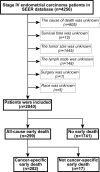A Novel Predictive Tool for Determining the Risk of Early Death From Stage IV Endometrial Carcinoma: A Large Cohort Study
- PMID: 33381462
- PMCID: PMC7769006
- DOI: 10.3389/fonc.2020.620240
A Novel Predictive Tool for Determining the Risk of Early Death From Stage IV Endometrial Carcinoma: A Large Cohort Study
Abstract
Background: Endometrial carcinoma is a common gynecological malignancy. Stage IV endometrial carcinoma is associated with a high risk of early death; however, there is currently no effective prognostic tool to predict early death in stage IV endometrial cancer.
Methods: Surveillance, Epidemiology, and End Results (SEER) data from patients with stage IV endometrial cancer registered between 2004 and 2015 were used in this study. Important independent prognostic factors were identified by univariate and multivariate logistic regression analyses. A nomogram of all-cause and cancer-specific early deaths was constructed using relevant risk factors such as tumor size, histological grade, histological classification, and treatment (surgery, radiotherapy, chemotherapy).
Results: A total of 2,040 patients with stage IV endometrial carcinoma were included in this study. Of these, 299 patients experienced early death (≤3 months) and 282 died from cancer-specific causes. The nomogram of all-cause and cancer-specific early deaths showed good predictive power and clinical practicality with respect to the area under the receiver operating characteristic curve and decision curve analysis. The internal validation of the nomogram revealed a good agreement between predicted early death and actual early death.
Conclusions: We developed a clinically useful nomogram to predict early mortality from stage IV endometrial carcinoma using data from a large cohort. This tool can help clinicians screen high-risk patients and implement individualized treatment regimens.
Keywords: SEER database; early death; endometrial carcinoma; nomograms; prognosis.
Copyright © 2020 Song, Wang, Zhou and Zhang.
Conflict of interest statement
The authors declare that the research was conducted in the absence of any commercial or financial relationships that could be construed as a potential conflict of interest.
Figures






Similar articles
-
A Novel Tool to Predict Early Death in Uterine Sarcoma Patients: A Surveillance, Epidemiology, and End Results-Based Study.Front Oncol. 2020 Nov 26;10:608548. doi: 10.3389/fonc.2020.608548. eCollection 2020. Front Oncol. 2020. PMID: 33324570 Free PMC article.
-
The novel predictive nomograms for early death in metastatic hepatocellular carcinoma: A large cohort study.Medicine (Baltimore). 2024 Jan 5;103(1):e36812. doi: 10.1097/MD.0000000000036812. Medicine (Baltimore). 2024. PMID: 38181257 Free PMC article.
-
The incidence, risk factors and predictive nomograms for early death among patients with stage IV gastric cancer: a population-based study.J Gastrointest Oncol. 2020 Oct;11(5):964-982. doi: 10.21037/jgo-20-217. J Gastrointest Oncol. 2020. PMID: 33209491 Free PMC article.
-
A Practical Nomogram to Predict Early Death in Advanced Epithelial Ovarian Cancer.Front Oncol. 2021 Mar 19;11:655826. doi: 10.3389/fonc.2021.655826. eCollection 2021. Front Oncol. 2021. PMID: 33816311 Free PMC article.
-
Nomogram for predicting the early death of patients with stage IV ovarian cancer: a retrospective analysis of the SEER database.Transl Cancer Res. 2024 Nov 30;13(11):5845-5855. doi: 10.21037/tcr-24-625. Epub 2024 Nov 27. Transl Cancer Res. 2024. PMID: 39697763 Free PMC article.
Cited by
-
Clinicopathological characteristics of endometrial carcinoma with different molecular subtypes and their correlation with lymph node metastasis.Am J Cancer Res. 2024 Aug 25;14(8):3994-4003. doi: 10.62347/FPUJ8382. eCollection 2024. Am J Cancer Res. 2024. PMID: 39267670 Free PMC article.
-
Development and Validation of a Simple-to-Use Nomogram to Predict Early Death in Metastatic Pancreatic Adenocarcinoma.Front Oncol. 2021 Sep 9;11:729175. doi: 10.3389/fonc.2021.729175. eCollection 2021. Front Oncol. 2021. PMID: 34568061 Free PMC article.
-
Risk factors of early mortality in patients with small cell lung cancer: a retrospective study in the SEER database.J Cancer Res Clin Oncol. 2023 Oct;149(13):11193-11205. doi: 10.1007/s00432-023-05003-7. Epub 2023 Jun 24. J Cancer Res Clin Oncol. 2023. PMID: 37354224 Free PMC article.
-
Nomogram models for the prognosis of cervical cancer: A SEER-based study.Front Oncol. 2022 Oct 6;12:961678. doi: 10.3389/fonc.2022.961678. eCollection 2022. Front Oncol. 2022. PMID: 36276099 Free PMC article.
-
Survival Analysis and Prediction Model of ASCP Based on SEER Database.Front Oncol. 2022 Jun 24;12:909257. doi: 10.3389/fonc.2022.909257. eCollection 2022. Front Oncol. 2022. PMID: 35814413 Free PMC article.
References
LinkOut - more resources
Full Text Sources

